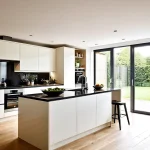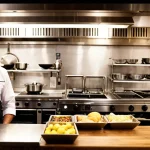Blending Classic and Modern: Key Approaches in UK Kitchen Design
Striking the perfect balance between traditional kitchen elements and sleek modernity defines many contemporary UK kitchens today. Designers artfully blend classic details like shaker cabinets, decorative corbels, and natural wood finishes with clean lines and innovative layouts. This integration brings warmth and heritage into a functional, up-to-date space.
A hallmark of this trend is the use of natural materials such as oak or pine alongside quartz or marble countertops. Brass or aged metal fixtures often complement stainless steel appliances, creating a layered aesthetic that honours tradition without sacrificing convenience.
Topic to read : How Will Brexit Affect Kitchen Trends in the UK?
For instance, many UK kitchens feature classic tiled splashbacks in muted hues paired with minimalist island units, giving a nod to the past while embracing the future. Popular UK kitchen trends also emphasise open-plan living, where an original farmhouse table might sit next to streamlined cabinetry.
This dynamic approach meets the desires of modern homeowners for style and practicality. By blending both worlds, UK kitchen design captures timeless elegance enriched by contemporary functionality—making spaces both beautiful and enduring.
Have you seen this : Is the Popularity of Open-Concept Kitchens in the UK Beginning to Decline?
Traditional Materials in Modern Kitchen Spaces
Blending traditional kitchen materials with contemporary aesthetics is a hallmark of many modern kitchen designs. Wood, stone, and heritage textiles continue to be popular choices, lending warmth and texture to sleek, modern kitchen finishes.
Wood remains a timeless element, often used for cabinetry or flooring. Its natural grain contrasts beautifully with minimalist surfaces like quartz or stainless steel. Stone surfaces—such as granite and marble—add both durability and elegance to countertops, serving as classic design staples in UK kitchens. These materials not only withstand daily use but also maintain their charm for years.
Heritage textiles find their place in the kitchen through upholstered seating or decorative accents, enhancing the tactile experience and visual interest. Designers skillfully pair these time-honoured elements with streamlined finishes to create spaces that feel both classic and fresh.
UK suppliers specializing in traditional kitchen materials offer a range of high-quality woods and natural stones, supporting bespoke projects that honour classic design while accommodating modern functionality. Their collections allow homeowners to mix authentic textures with contemporary style, perfectly aligning with the evolving tastes of today’s kitchen interiors.
Understanding how traditional materials interact with new design trends ensures that kitchens remain inviting without sacrificing practicality or sophistication.
Heritage Fixtures and Features: Old Meets New
Blending kitchen fixtures UK that echo tradition with contemporary design brings timeless charm to modern homes. Belfast sinks, known for their deep basins and distinctive style, remain a popular choice when combining historical appeal with functionality. These sinks anchor the kitchen’s character while accommodating today’s demands for durability and ease of cleaning.
Similarly, Aga ranges continue to be iconic fixtures. Originally heat-retaining cast iron stoves, modern versions include smarter technology, retaining their classic look but enhancing cooking control. This careful balance keeps the nostalgic feel alive but increases efficiency.
Shaker cabinets exemplify traditional fittings with simple, clean lines that lend themselves well to contemporary kitchen hardware complements. Their minimalist craftsmanship integrates seamlessly with newer materials and finishes, bridging eras without clash.
Modern interpretations of classic hardware, such as brass handles reworked with sleeker profiles or lighting fixtures inspired by vintage designs but using LED technology, add thoughtful touches. When selecting fixtures, consider sourcing from UK specialists who focus on pieces that marry heritage appeal and contemporary quality—this ensures your kitchen remains both stylish and practical.
This approach preserves rich character while embracing innovation—striking the perfect balance between old and new in your kitchen design.
Colour Palettes and Styling: Mixing Timeless with Trendy
When exploring kitchen colour schemes, the key to a captivating space lies in blending traditional colours with contemporary accents. Classic shades such as deep navy, soft cream, and muted greens often serve as a timeless foundation. These hues bring warmth and familiarity, rooted in enduring design aesthetics.
To introduce a modern twist, many UK kitchens incorporate bolder tones like charcoal greys or matte black, balanced against natural wood finishes or white quartz countertops. This creates an appealing contrast that elevates the overall look without overwhelming the room.
Techniques like panelling and mouldings add texture and dimension, enriching the visual interest of cabinetry. These decorative accents can turn a basic kitchen into an inviting statement piece, subtly reflecting heritage without feeling outdated.
Recent UK kitchen projects illustrate how these methods converge effectively. For instance, combining traditional panelled doors painted in classic shades with sleek, minimalist hardware demonstrates a refined fusion of eras. This approach allows for a versatile space that remains stylish over the long term, satisfying both those who appreciate history and lovers of contemporary kitchen styling UK trends alike.
Expert Perspectives and Real UK Case Studies
London-based kitchen design experts UK emphasize the importance of balancing tradition and modernity to create timeless spaces. Designers point out that integrating classic elements such as natural wood or shaker-style cabinetry with sleek appliances and open shelving results in kitchens that are both functional and visually appealing.
Several case studies across UK homes highlight varied approaches. For example, a Surrey residence combined handmade cabinetry with state-of-the-art lighting and smart storage solutions. This project illustrates how traditional wood finishes paired with modern tech offer efficiency without compromising warmth. Another case involved blending period features like exposed beams with minimalist countertops in a Cotswolds home, showcasing how contrast can elevate aesthetic appeal.
What makes these projects successful? Experts agree it’s the thoughtful marriage of traditional modern kitchen projects that respects heritage while embracing innovation. Functionality comes from practical layouts, durable materials, and clever storage; aesthetics are achieved through harmonious colour palettes and textures. User feedback often reflects satisfaction with ease of use alongside inviting atmospheres, indicating that design strategies are meeting real-life needs.
In essence, the finest kitchens emerge when designers use experience to tailor solutions that honour both past and present — creating spaces that delight and endure.
Practical Guidelines for Combining Classic and Contemporary Styles
Blending kitchen styles can be a rewarding challenge that brings both character and modern functionality to your home. When considering kitchen remodel tips UK, start by identifying core elements you wish to preserve and the contemporary upgrades you want to introduce. For example, pairing classic cabinetry with sleek, modern lighting creates a balanced contrast that feels intentional—not cluttered.
Homeowners should focus on harmony between tradition and innovation. Combining natural materials like wood with stainless steel finishes respects architectural heritage while embracing current trends. Thoughtful color schemes unify these elements—soft neutrals and muted tones often work well to bridge styles seamlessly.
To avoid overwhelming your space, select statement pieces from either style sparingly. For instance, a traditional mantle range hood coupled with minimalist, handleless drawers allows each feature to shine without competing. This tailored approach ensures your kitchen reflects your personal style and complements your home’s architecture.
In the UK, numerous designers specialize in hybrid kitchens and can provide tailored homeowner advice. Engaging with local retailers familiar with both classic and contemporary trends offers access to unique materials and expert guidance. Exploring trusted resources helps you make informed choices and achieve a cohesive, stylish kitchen remodel.


